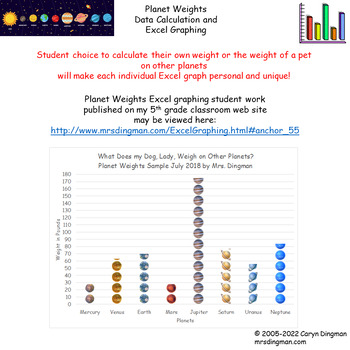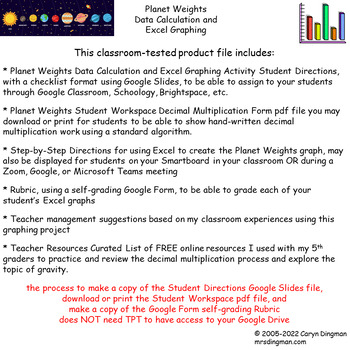Excel Graphing Planet Weights with Digital Student Directions
- PDF
- Google Apps™
- Excel Spreadsheets

Description
Does your curriculum include a study of the solar system and/or forces and motion?
Want to give your students a real-world and personal way to practice decimal multiplication?
This Planet Weights Excel Project can be an engaging way to:
* integrate technology, math, and Next Generation Science and Engineering Practices
* introduce, extend, or enrich a math and science topic of study
* introduce or practice creating sheets and charts using Excel
* give students a chance to make connections across the content areas
I originally created this Excel graphing activity as a way to practice decimal multiplication and integrate technology into my Math classes, extending and enriching instruction.
I wanted to encourage my students to find a balance between practicing hand-written decimal multiplication work using a standard algorithm, and gaining comfort and confidence using Excel sheets and charts.
I revised and updated my paper directions to continue to showcase student confidence and competence using available technology in a digital way.
This classroom-tested product file includes:
* Planet Weights Data Calculation and Excel Graphing Activity Student Directions, with a checklist format using Google Slides, to be able to assign to your students through Google Classroom, Schoology, Brightspace, etc.
* Planet Weights Student Workspace Decimal Multiplication Form pdf file you may download or print for students to be able to show hand-written decimal multiplication work using a standard algorithm.
* Step-by-Step Directions for using Excel to create the Planet Weights graph, may also be displayed for students on your Smartboard in your classroom OR during a Zoom, Google, or Microsoft Teams meeting
* Rubric, using a self-grading Google Form, to be able to grade each of your student’s Excel graphs
* Teacher management suggestions based on my classroom experiences using this graphing project
* Teacher Resources Curated List of FREE online resources I used with my 5th graders to practice and review the decimal multiplication process and explore the topic of gravity.
The process to make a copy of the Student Directions Google Slides file, download or print the Student Workspace pdf file, and make a copy of the Google Form self-grading Rubric does NOT need TPT to have access to your Google Drive
* my students were given a choice to calculate their own weight OR the weight of a pet
* my students were able to complete this project with two or three 15-minute small group center sessions
* my 5th graders completed this project as a performance task- small groups of students working independently on Chromebooks or desktop computers in rotating 15-minute turns during my 90-minute Math block, working at their own pace through the project checklist directions
* I’ve used this project with younger students, or students needing adaptations, in small groups as well- reading the project checklist directions aloud to those small groups for a 10 or 15-minute rotating center turn
* Bring your Planet Weights Excel-lent graphing project bulletin board to your students’ families! Consider creating a pdf file for each student’s final color Excel graph and create an online “book” to share with families digitally
See student work on my classroom web site:
http://www.mrsdingman.com/ExcelGraphing.html#anchor_55





